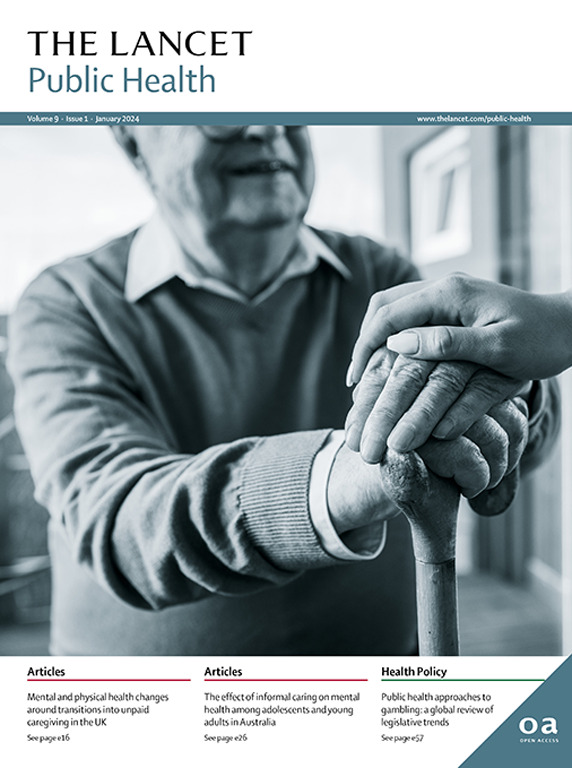Maternal ethnic group, socioeconomic status, and neonatal and child mortality: a nationwide cohort study in England and Wales
IF 25.2
1区 医学
Q1 PUBLIC, ENVIRONMENTAL & OCCUPATIONAL HEALTH
引用次数: 0
Abstract
Background
The UK currently has one of the highest rates of child mortality in Europe. Robust population-level estimates of differences in neonatal and child mortality by ethnic and socioeconomic group are currently scarce for England and Wales. We aimed to examine variation in neonatal and child mortality by maternal ethnic group and indicators of socioeconomic status to help understand which groups are most at risk of neonatal and child mortality.Methods
In this nationwide cohort study, we used linked population-level data for England and Wales, comprising birth registrations and notifications (2011–16), Census 2011, and death registrations (2011–21). Our population was restricted to livebirths, post-24 weeks’ gestation, and to mothers aged 12 years or older at time of birth. Our primary exposures were self-reported maternal ethnic group, household socioeconomic position, and maternal education from Census 2011. We estimated mortality rates and hazard ratios from Cox proportional hazards models for different ethnic and socioeconomic groups separately for neonatal (<28 days) and child (from ≥28 days to 10 years) mortality. We adjusted for sex of baby; birth term; suspected congenital anomaly; maternal age; disability; country of birth; main language; and household tenure, region, and rural or urban location. Babies were followed from birth for up to 10 years and until Dec 31, 2021, or death, whichever occurred earlier.Findings
A total of 3 018 020 babies were included in our cohort, with the average age of the mother at delivery being 29·8 years (IQR 26–34). There were 4750 neonatal deaths and 5205 child deaths in the follow-up period. Compared with White British mothers, babies born to Pakistani mothers (hazard ratio [HR] 2·39 [95% CI 2·15–2·66]) or Black African mothers (HR 1·65 [1·43–1·91]) had the highest risk of neonatal mortality. These differences remained after fully adjusting the models for maternal, household, and gestational characteristics (adjusted HR 1·95 [95% CI 1·72–2·22] and HR 1·38 [1·15–1·66], for babies born to Pakistani and Black African mothers, respectively). The differences in child mortality by maternal ethnic group were similar and remained after accounting for maternal, household, and gestational characteristics. For socioeconomic factors, babies born to mothers with no formal education (HR 1·55 [95% CI 1·42–1·69]) or living in households with long-term unemployment (HR 1·93 [95% CI 1·69–2·19]) were most at risk from neonatal death compared with babies born to mothers who had school- level qualifications or in households where the main earner was employed in a higher managerial, administrative and professional occupation, respectively. Differences in neonatal and child mortality by education persisted for the models, accounting for maternal, household, and gestational characteristics.Interpretation
Health inequalities exist from birth; the present findings identify the most at-risk groups, which should be targeted in future research to uncover the causal pathways underpinning neonatal and child mortality.Funding
None.母亲族群、社会经济地位、新生儿和儿童死亡率:英格兰和威尔士的一项全国性队列研究
英国目前是欧洲儿童死亡率最高的国家之一。在英格兰和威尔士,目前还缺乏按种族和社会经济群体对新生儿和儿童死亡率差异的人口水平的可靠估计。我们的目的是检查产妇种族和社会经济地位指标在新生儿和儿童死亡率方面的差异,以帮助了解哪些群体的新生儿和儿童死亡率最高。方法在这项全国性队列研究中,我们使用了英格兰和威尔士的相关人口水平数据,包括出生登记和通知(2011 - 16年)、2011年人口普查和死亡登记(2011 - 21年)。我们的人群仅限于活产,妊娠24周后,以及出生时年龄在12岁或以上的母亲。我们的主要暴露是2011年人口普查中自我报告的母亲种族、家庭社会经济地位和母亲教育程度。我们根据不同种族和社会经济群体的Cox比例风险模型分别估计了新生儿(28天)和儿童(≥28天至10岁)死亡率和风险比。我们根据婴儿的性别进行了调整;出生术语;疑似先天性异常;母亲的年龄;残疾;出生国家;主要语言;以及家庭所有制、地区、农村或城市位置。婴儿从出生到2021年12月31日(或死亡,以较早者为准)被跟踪长达10年。结果本队列共纳入3 018 020例婴儿,产妇平均分娩年龄为29.8岁(IQR 26-34)。在随访期间,有4750名新生儿死亡,5205名儿童死亡。与英国白人母亲相比,巴基斯坦母亲(危险比[HR] 2.39 [95% CI 2.15 - 2.66])或非洲黑人母亲(危险比[HR] 1.65[1.43 - 1·91])所生婴儿的新生儿死亡风险最高。在完全调整了母亲、家庭和妊娠特征的模型后,这些差异仍然存在(调整后的HR分别为1.95 [95% CI 1.72 - 2·22]和1.38[1.15 - 1.66],分别针对巴基斯坦和非洲黑人母亲所生的婴儿)。在考虑了母亲、家庭和妊娠特征后,不同种族的儿童死亡率的差异是相似的。在社会经济因素方面,母亲未受过正规教育(HR 1.55 [95% CI 1.42 - 1·69])或生活在长期失业家庭(HR 1.93 [95% CI 1.69 - 2·19])的婴儿与母亲受过学校教育或主要收入来源从事较高管理、行政和专业职业的家庭所生的婴儿相比,新生儿死亡风险最高。考虑到母亲、家庭和妊娠期的特征,在模型中,新生儿和儿童死亡率因教育而存在差异。健康不平等从出生就存在;目前的发现确定了最危险的群体,未来的研究应该针对这些群体,以揭示新生儿和儿童死亡的因果关系。
本文章由计算机程序翻译,如有差异,请以英文原文为准。
求助全文
约1分钟内获得全文
求助全文
来源期刊

Lancet Public Health
Medicine-Public Health, Environmental and Occupational Health
CiteScore
55.60
自引率
0.80%
发文量
305
审稿时长
8 weeks
期刊介绍:
The Lancet Public Health is committed to tackling the most pressing issues across all aspects of public health. We have a strong commitment to using science to improve health equity and social justice. In line with the values and vision of The Lancet, we take a broad and inclusive approach to public health and are interested in interdisciplinary research.
We publish a range of content types that can advance public health policies and outcomes. These include Articles, Review, Comment, and Correspondence. Learn more about the types of papers we publish.
 求助内容:
求助内容: 应助结果提醒方式:
应助结果提醒方式:


